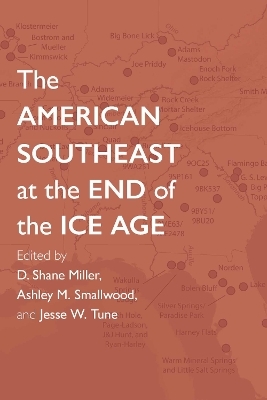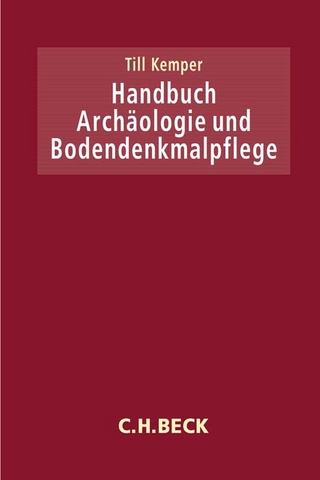
The American Southeast at the End of the Ice Age
The University of Alabama Press (Verlag)
978-0-8173-6192-1 (ISBN)
The definitive book on what is known about the Late Pleistocene and Early Holocene archaeological record in the Southeast
The 1996 benchmark volume The Paleoindian and Early Archaic Southeast, edited by David G. Anderson and Kenneth E. Sassaman, was the first study to summarize what was known of the peoples who lived in the Southeast when ice sheets covered the northern part of the continent and mammals such as mammoths, saber-toothed cats, and ground sloths roamed the landscape.
The American Southeast at the End of the Ice Age provides an updated, definitive synthesis of current archaeological research gleaned from an array of experts in the region. It is organized in three parts: state records, the regional perspective, and reflections and future directions. Chapters survey a diversity of topics including the distribution of the earliest archaeological sites in the region, chipped-stone tool technology, the expanding role of submerged archaeology, hunter-gatherer lifeways, past climate changes and the extinction of megafauna on the transitional landscape, and evidence of demographic changes at the end of the Ice Age. Discussion of the ethical responsibilities regarding the use of private collections and the relationship of archaeologists and the avocational community, insight from outside the Southeast, and considerations for future research round out the volume.
D. Shane Miller is associate professor of anthropology at Mississippi State University. He is author of From Colonization to Domestication: Population, Environment, and the Origins of Agriculture in Eastern North America. Ashley M. Smallwood is associate professor of anthropology at the University of Louisville. She is coeditor of Clovis: On the Edge of a New Understanding. Jesse W. Tune is associate professor of anthropology at Fort Lewis College.
Preface Introduction: Five Big Questions for the Study of the Late Pleistocene and Early Holocene Archaeological Record in the American Southeast
D. Shane Miller, Ashley M. Smallwood, and Jesse W. Tune
Part I. State Records: Key Sites and Research
Chapter 1. Late Pleistocene and Early Holocene Archaeology in Alabama, Past and Present
Steven M. Meredith
Chapter 2. Evidence of Paleoindians in the Highlands and Lowlands of Arkansas
Juliet E. Morrow, J. Christopher Gillam, Sarah D. Stuckey, and Sean A. Roades
Chapter 3. The Late Pleistocene and Early Holocene Archaeology of Florida
Jessi J. Halligan and Grayal E. Farr
Chapter 4. Paleoindian and Early Archaic Research in Georgia
Ashley M. Smallwood, Thomas A. Jennings, K. C. Jones, and Sydney O’Brien
Chapter 5. An Overview of Paleoindian Occupations in Kentucky
Kary L. Stackelbeck and Greg J. Maggard
Chapter 6. Louisiana Paleoindian and Early Archaic
Thomas A. Jennings and Charlotte D. Pevny
Chapter 7. A Summary of Paleoindian and Early Archaic Research in Mississippi
Derek T. Anderson, James L. Strawn, Samuel O. Brookes, and D. Shane Miller
Chapter 8. Recent Developments in Paleoindian and Early Archaic Research in North Carolina
I. Randolph Daniel Jr. and Christopher R. Moore
Chapter 9. Paleoindian and Early Archaic South Carolina
Kara Bridgman Sweeney, J. Christopher Gillam, and Christopher R. Moore
Chapter 10. Paleoindian and Early Archaic Research in Tennessee: The Past, Present, and Future
Jesse W. Tune, Jay D. Franklin, and Lauren M. Franklin
Chapter 11. Evolving Perspectives on Virginia’s Paleoindian Record
Joseph A. M. Gingerich and William A. Childress
Part II. The Regional Perspective
Chapter 12. Paleoindian Lithic Resources and Mobility: A Model for the Southeast
Ryan M. Parish and Adam M. Burke
Chapter 13. Contributions of Submerged Archaeological Research to the Late Pleistocene and Early Holocene Record of the Southeast
Morgan F. Smith, Shawn A. Joy, Michael R. Waters, Jessi J. Halligan, Michael K. Faught, David K. Thulman, Angelina G. Perrotti, Brendan Fenerty, Ryan Duggins, and Adam M. Burke
Chapter 14. Stalking the Most Predictable Prey: Early Gatherers in the Eastern Woodlands
Kandace D. Hollenbach and Stephen B. Carmody
Chapter 15. Plant and Animal Communities in the Southeastern United States during the Late Pleistocene
Chris Widga, Derek T. Anderson, and Renee B. Whitman
Chapter 16. The Organization of Early Archaic Chipped Stone Technology: A Case Study
Katherine McMillan Barry and Philip J. Carr
Chapter 17. Dust Cave: A Retrospective
Sarah C. Sherwood
Chapter 18. Southeastern Late Paleoindian through Early Archaic Chronologies
David K. Thulman
Chapter 19. A Large-Scale Appraisal of Paleoindian Spatial Demography in the Eastern Woodlands
Andrew A. White and David G. Anderson
Chapter 20. Ethical Considerations in the Development and Maintenance of Large Research Databases: The Paleoindian Database of the Americas (PIDBA) Example
David G. Anderson and D. Shane Miller
Part III. Perspective and Future Directions for Archaeology in the American Southeast at the End of the Last Ice Age
Chapter 21. An Outsider’s View of Paleoindian Archaeology in the Southeast
Vance T. Holliday
Chapter 22. Five Future Directions for Late Pleistocene and Early Holocene Archaeology in the American Southeast
D. Shane Miller, Ashley M. Smallwood, and Jesse W. Tune
References Cited
Contributors
Index
| Erscheinungsdatum | 03.09.2024 |
|---|---|
| Reihe/Serie | Archaeology of the American South: New Directions and Perspectives |
| Zusatzinfo | 37 B&W figures - 47 maps - 29 tables |
| Verlagsort | Alabama |
| Sprache | englisch |
| Maße | 152 x 229 mm |
| Gewicht | 454 g |
| Themenwelt | Geisteswissenschaften ► Archäologie |
| Sozialwissenschaften ► Ethnologie | |
| Sozialwissenschaften ► Soziologie | |
| ISBN-10 | 0-8173-6192-8 / 0817361928 |
| ISBN-13 | 978-0-8173-6192-1 / 9780817361921 |
| Zustand | Neuware |
| Haben Sie eine Frage zum Produkt? |
aus dem Bereich


